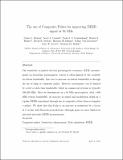Files in this item
The use of composite pulses for improving DEER signal at 94 GHz
Item metadata
| dc.contributor.author | Motion, Claire L. | |
| dc.contributor.author | Cassidy, Scott L. | |
| dc.contributor.author | Cruickshank, Paul A. S. | |
| dc.contributor.author | Hunter, Robert I. | |
| dc.contributor.author | Bolton, David R. | |
| dc.contributor.author | El Mkami, Hassane | |
| dc.contributor.author | Van Doorslaer, Sabine | |
| dc.contributor.author | Lovett, Janet E. | |
| dc.contributor.author | Smith, Graham M. | |
| dc.date.accessioned | 2018-04-03T23:34:18Z | |
| dc.date.available | 2018-04-03T23:34:18Z | |
| dc.date.issued | 2017-05 | |
| dc.identifier | 249549089 | |
| dc.identifier | d21a9c02-77ef-4b2d-94df-223b1bf282eb | |
| dc.identifier | 85017193999 | |
| dc.identifier | 000400723900014 | |
| dc.identifier.citation | Motion , C L , Cassidy , S L , Cruickshank , P A S , Hunter , R I , Bolton , D R , El Mkami , H , Van Doorslaer , S , Lovett , J E & Smith , G M 2017 , ' The use of composite pulses for improving DEER signal at 94 GHz ' , Journal of Magnetic Resonance , vol. 278 , pp. 122-133 . https://doi.org/10.1016/j.jmr.2017.03.018 | en |
| dc.identifier.issn | 1090-7807 | |
| dc.identifier.other | RIS: urn:6068FF4F1A5F56EC96CD855DDAA852C1 | |
| dc.identifier.other | ORCID: /0000-0002-3561-450X/work/40301296 | |
| dc.identifier.other | ORCID: /0000-0001-6578-7412/work/59464764 | |
| dc.identifier.other | ORCID: /0000-0002-0552-5784/work/60195398 | |
| dc.identifier.other | ORCID: /0000-0002-0415-9540/work/60195463 | |
| dc.identifier.uri | https://hdl.handle.net/10023/13061 | |
| dc.description | C.L.M. acknowledges funding from EPSRC as part of the iMRCDT. The W-band instrument was developed under the U.K. Research Councils Basic Technology Program (grant EP/F039034/1). S.V.D. acknowledges the Research Foundation Flanders (FWO) for financial support (grant G.0687.13). J.E.L. thanks the Royal Society for a University Research Fellowship. Sylvia Dewilde (Biomedical Sciences, University of Antwerp) is thanked for the purification of the Cys46Ser/ Cys55Ser mutant of human neuroglobin (NGB) used in this work. Adelheid Godt’s group is thanked for the synthesis of MSA236. We also thank the Wellcome Trust (grant 099149/Z/12/Z). The research data (and/or materials) supporting this publication can be accessed at http://dx.doi.org/10.17630/b65d05e6-6efa-48b9-a741-5a6322159a4a. | en |
| dc.description.abstract | The sensitivity of pulsed electron paramagnetic resonance (EPR) measurements on broad-line paramagnetic centers is often limited by the available excitation bandwidth. One way to increase excitation bandwidth is through the use of chirp or composite pulses. However, performance can be limited by cavity or detection bandwidth, which in commercial systems is typically 100-200 MHz. Here we demonstrate in a 94 GHz spectrometer, with > 800 MHz system bandwidth, an increase in signal and modulation depth in a 4-pulse DEER experiment through use of composite rather than rectangular π pulses. We show that this leads to an increase in sensitivity by a factor of 3, in line with theoretical predictions, although gains are more limited in nitroxide-nitroxide DEER measurements. | |
| dc.format.extent | 12 | |
| dc.format.extent | 1968373 | |
| dc.language.iso | eng | |
| dc.relation.ispartof | Journal of Magnetic Resonance | en |
| dc.subject | Composite pulses | en |
| dc.subject | Sensitivity enhancement | en |
| dc.subject | Echo simulation | en |
| dc.subject | DEER | en |
| dc.subject | PELDOR | en |
| dc.subject | Broadband non-resonant | en |
| dc.subject | W-band | en |
| dc.subject | Instrumentation | en |
| dc.subject | QC Physics | en |
| dc.subject | DAS | en |
| dc.subject.lcc | QC | en |
| dc.title | The use of composite pulses for improving DEER signal at 94 GHz | en |
| dc.type | Journal article | en |
| dc.contributor.sponsor | EPSRC | en |
| dc.contributor.sponsor | The Royal Society | en |
| dc.contributor.sponsor | The Wellcome Trust | en |
| dc.contributor.institution | University of St Andrews. School of Physics and Astronomy | en |
| dc.contributor.institution | University of St Andrews. Biomedical Sciences Research Complex | en |
| dc.identifier.doi | 10.1016/j.jmr.2017.03.018 | |
| dc.description.status | Peer reviewed | en |
| dc.date.embargoedUntil | 2018-04-02 | |
| dc.identifier.url | http://www.sciencedirect.com/science/article/pii/S1090780717300903#appd003 | en |
| dc.identifier.grantnumber | EP/F039034/1 | en |
| dc.identifier.grantnumber | UF090121 | en |
| dc.identifier.grantnumber | 099149/Z/12/Z | en |
This item appears in the following Collection(s)
Items in the St Andrews Research Repository are protected by copyright, with all rights reserved, unless otherwise indicated.

